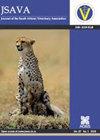2015-2016年南非禽肉制品中耐抗生素金黄色葡萄球菌分离株的流行率和风险因素
IF 0.9
4区 农林科学
Q3 VETERINARY SCIENCES
Journal of the South African Veterinary Association
Pub Date : 2019-08-29
DOI:10.4102/jsava.v90i0.1738
引用次数: 13
摘要
金黄色葡萄球菌,包括耐甲氧西林菌株,已在全球动物源性食品中检测到。关于导致南非食源性病原体产生抗生素耐药性的因素的报告数据有限。本研究的主要目的是确定金黄色葡萄球菌(包括耐抗生素菌株)在家禽肉制品中的流行情况,并评估耐抗生素金黄色葡萄球菌分离株污染家禽肉制品的潜在危险因素。在南非九个省的城市进行了横断面调查,其中包括南非主要入境口岸的屠宰场、肉类加工设施、零售店和冷库。采用Kirby-Bauer圆盘扩散法检测了从各种家禽肉制品中分离出的金黄色葡萄球菌对10类14种抗生素化合物的敏感性。使用逻辑回归模型评估潜在的危险因素。在311份检测样本中,金黄色葡萄球菌阳性的占34.1% (n = 106)(95%可信区间[CI], 28.9% ~ 39.7%)。从106株中随机抽取72株进行抗生素敏感性试验。21% (n = 15)的分离株为耐甲氧西林菌株(95% CI, 12.2% ~ 32.0%)。其中,有22.2% (n = 16)的分离菌存在多重耐药(95% CI为13.3% ~ 33.6%)。产品来源(p = 0.160)、肉制品类型(p = 0.962)、设施类型(p = 0.115)和设施卫生规范(p = 0.484)与耐甲氧西林菌株污染禽肉产品无显著关联。该研究为包括金黄色葡萄球菌在内的食源性病原体抗生素耐药性风险评估的进一步研究提供了基线数据,这将指导2017-2024年南非国家抗菌素耐药性战略框架的实施计划。本文章由计算机程序翻译,如有差异,请以英文原文为准。
Prevalence and risk factors contributing to antibiotic-resistant Staphylococcus aureus isolates from poultry meat products in South Africa, 2015–2016
Staphylococcus aureus, including methicillin-resistant strains, has been detected in food products of animal origin globally. Limited data have been reported on the factors contributing to antibiotic resistance of food-borne pathogens in South Africa. The primary aim of this study was to determine the prevalence of S. aureus, including antibiotic-resistant strains, in poultry meat products as well as the evaluation of potential risk factors for contamination of poultry meat products with antibiotic-resistant S. aureus isolates. A cross-sectional investigation was conducted in municipalities located across the nine provinces of South Africa, which included abattoirs, meat processing facilities, retail outlets and cold stores at the major ports of entry into South Africa. Staphylococcus aureus isolates obtained from various poultry meat products were tested for susceptibility to 14 antibiotic compounds representing 10 antibiotic classes using the Kirby–Bauer disc diffusion method. Potential risk factors were evaluated using a logistic regression model. Of the 311 samples tested, 34.1% (n = 106) were positive for S. aureus (95% confidence interval [CI], 28.9% – 39.7%). Seventy-two of the 106 isolates were randomly selected for antibiotic sensitivity testing. Twenty-one per cent (n = 15) of the isolates selected for sensitivity testing were methicillin-resistant strains (95% CI, 12.2% – 32.0%). Multi-drug resistance was detected in 22.2% (n = 16) of these isolates tested (95% CI, 13.3% – 33.6%). Origin of the product (p = 0.160), type of meat product (p = 0.962), type of facility (p = 0.115) and facility hygiene practices (p = 0.484) were not significantly associated with contamination of poultry meat products with methicillin-resistant strains. The study provides baseline data for further studies on antibiotic resistance risk assessments for food-borne pathogens, including S. aureus, which should guide the implementation plans of the South African National Antimicrobial Resistance Strategy Framework, 2017–2024.
求助全文
通过发布文献求助,成功后即可免费获取论文全文。
去求助
来源期刊

Journal of the South African Veterinary Association
VETERINARY SCIENCES-
CiteScore
1.50
自引率
0.00%
发文量
23
审稿时长
22 weeks
期刊介绍:
The Journal of the South African Veterinary Association is a contemporary multi-disciplinary scientific mouthpiece for Veterinary Science in South Africa and abroad. It provides veterinarians in South Africa and elsewhere in the world with current scientific information across the full spectrum of veterinary science. Its content therefore includes reviews on various topics, clinical and non-clinical articles, research articles and short communications as well as case reports and letters.
 求助内容:
求助内容: 应助结果提醒方式:
应助结果提醒方式:


